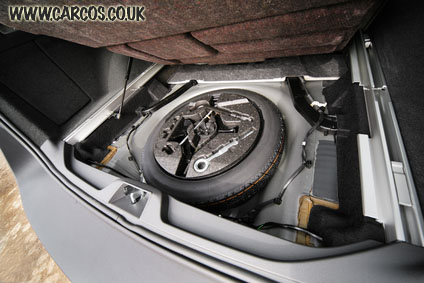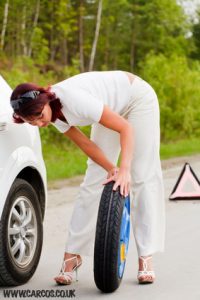Having your tyre punctured is just an unfortunate consequence of every day driving. There are tons of hazards out there on the roads such as screws, nails, pieces of metal, jagged rocks, etc all which can pose a threat of puncturing your tire during a drive. In this easy to follow guide on how to change a wheel, we will go over all of the steps to getting your wheel replaced in a safe and timely manner so you can continue on with your trip.
An Easy to Follow Guide on How to Change a Wheel
If your wheel is severely punctured during your drive and air is leaking out of the tyre, you need to find a safe spot to pull over. Preferably exit the motorway or road and find a safe parking area to assess the damage. If you must pull over on the side of the road, make sure you pull far into the shoulder and turn on your hazard lights. Engage your hand break and put the transmission in park if automatic, if manual place in second gear and turn off the engine before releasing the clutch pedal or you’ll jerk the car and it will stall the engine (it can be very embarrassing if you have passengers) this will avoid the car from rolling. Since you will be jacking the car up, it’s important to place large rocks in front of and behind the wheel diagonally located from the punctured wheel. For example, if the drivers’s side wheel is flat, you want to place rocks in front of and behind the back right. This prevents the car from rolling when the vehicle doesn’t have all 4 wheels on the ground (this is to be extra safe, but essential if on an incline).

Next in our guild to how to change a wheel, you’ll want to locate your car jack, lug nut wrench, and spare tire. These are typically all located under the floor board in the boot of your vehicle. Remove all of these items and set them at a safe and convenient location next to your wheel. If you have centre caps or wheel trims on, now is a good time to remove it and place it in your vehicle in order to prevent it from being scratched up as well as allowing access to the lug nuts. You’ll then want to loosen each of the lug nuts on the affected wheel about a half of a turn to one turn each, but no more. This is important as once the wheel is lifted it will be almost impossible to loosen the nuts as the wheel will just spin or jerk the car about. Once the lug nuts have been loosened, you’ll need to find your car’s jacking point. Older vehicles can be jacked up via the frame, however most new cars will have specific spots which are designated by two notches/tabs underneath one of the doors near the area the jack spot is on. Slide the jack under the spot so the flat head of the jack will contact the jack point on the vehicle.
 How to Change a Wheel – Removing the Flat Wheel
How to Change a Wheel – Removing the Flat Wheel
Raise the vehicle by operating the jack slowly and safely, ensuring the car isn’t attempting to roll once it begins lifting off the ground. Continue raising the vehicle until there’s enough space between the bottom of the wheel and the ground for the new wheel to fit on. The spare tyre will usually be thicker in diameter due to the flat being deflated, so you may need to raise it slightly more than you expect. With the flat wheel suspended up in the air, finish removing all of the loose lug nuts. Place them in a safe spot where they won’t get lost or roll away. Once the lug nuts have been removed, pulling the wheel straight out from the vehicle towards yourself will allow it to slide right off. Lay the flat wheel down safely so it won’t roll away or get in your way when placing the spare tyre on.
Replacing with Spare Wheel
Lift up the spare, aligning the holes in the wheel with the stud bolts on the car and push it inwards until it rests flat where the old wheel was. Place the lug nuts back on with the rounded end of the nuts towards the wheel base. Hand tighten them all until they’re fairly even. Once all lug nuts are hand tightened, use your lug nut wrench to tighten them as hard as you can without straining yourself. You can then lower the vehicle until the wheel touches the ground again. At this point, tighten the lug nuts again. You may then lower the vehicle until you are able to remove the jack from underneath the vehicle. Once the jack is removed and the car is on all four wheels completely, tighten the lug nuts a final time. Place your jack, the flat tyre, and the lug nut wrench back in the boot of your vehicle.
Depending on the type of spare tyre your vehicle came with, you may be restricted to under a certain speed until you get a full wheel replacement. These tyres, often referred to as “Donuts” or “Space Savers”, only serve to get you to a garage where you can purchase a new tyre. Space Savers should be removed from your vehicle as soon as possible.
So going over our guild to how to change a wheel again in numbered list:
- Find a save place to park
- Make sure your car is secure and won’t roll away
- Locate all your tools and spare wheel
- Remove center caps or wheel trims (if on wheel)
- Loosen lug nuts (no more than one turn)
- Jack up your car using right locators
- Raise car from ground giving enough clearence
- Remove lug nuts and place in safe area
- Pull wheel straight out (lay flat and out of the way)
- Put spare wheel on to the same place
- Hand tighten all lug nuts to secure spare wheel
- Lower vehicle until just touching ground
- Tighten lug nut with lug nut wrench
- Lower jack further until clear of car and remove
- Final tighten of lug nuts
- Replace all tools and flat tyre in to boot
Complete. Job done and you can now carry on with your day.
We hope this guild to how to change a wheel if you have a puncture was helpful.
Can you change a wheel by yourself?
Yes, we are pretty sure that you or anyone who knows how to do it can change their car wheels by themselves. The ability to replace your own tires does not exempt you from having your automobile serviced on a regular basis. However, if you ever need to visit an auto shop, completing the maintenance yourself will spare you the cost of hiring a mechanic to complete that specific task. They are only necessary for tasks like wheel balance and alignment that should be handled by a professional. It would be wise to have an alignment if you purchase brand-new tires. Alternatively, if you notice that your present tires are wearing unevenly, it could be because of inadequate alignment.

